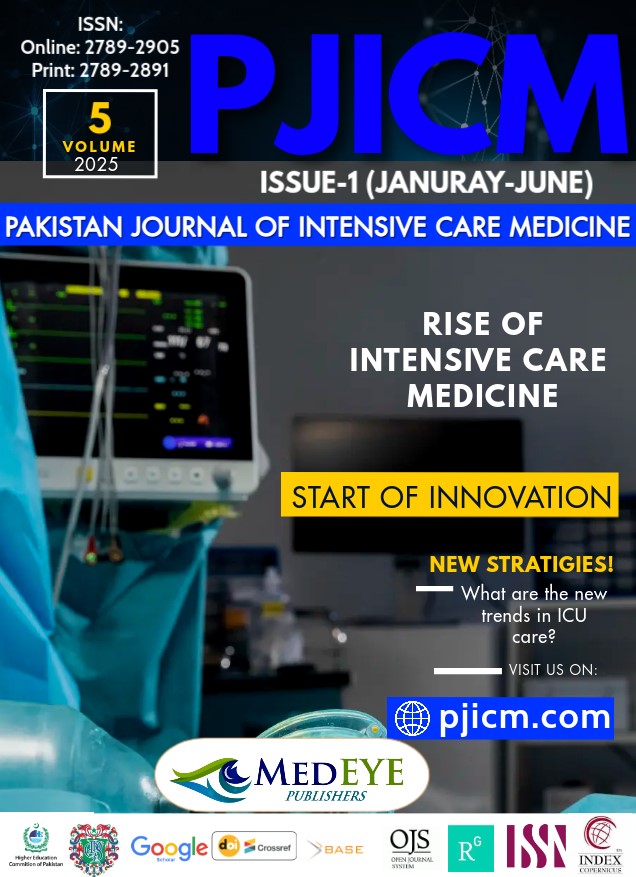FREQUENCY OF ANTENATAL COMPLICATIONS AMONG GRAND MULTIPAROUS WOMEN
DOI:
https://doi.org/10.54112/pjicm.v5i01.108Keywords:
Grand Multiparity, Antenatal Complications, Anemia, Pregnancy-Induced Hypertension, Placenta Previa, Maternal HealthAbstract
Background: Identifying antenatal complications in this group remains crucial to improving obstetric outcomes. Objective: To evaluate the frequency of antenatal complications among grand multiparous women presenting at a tertiary care hospital. Study Design: Cross-sectional descriptive study. Setting: Conducted at a tertiary care hospital (Department of Obstetrics and Gynecology, Saidu group of teaching hospital, Swat, Pakistan). Duration of Study: 11-October-2024 to 11-April-2025. Methods: A total of 164 grand multiparous women aged 25 to 40 years, with gestational ages beyond 28 weeks, were included. Anemia was defined as hemoglobin <11 g/dL with clinical symptoms such as pallor or dizziness. Pregnancy-induced hypertension (PIH) was defined as new-onset hypertension ≥140/90 mmHg on two readings without proteinuria. Placenta previa was diagnosed via ultrasound, showing placental coverage of the cervical os. Descriptive and inferential statistics were applied to evaluate frequencies and associations. Results: The mean age of participants was 32.4 ± 4.8 years. Anemia was the most frequent complication (65.9%), followed by pregnancy-induced hypertension (20.7%) and placenta previa (15.9%). No statistically significant associations were observed between complications and patient demographics. Conclusion: Grand multiparity continues to pose substantial antenatal risks, particularly anemia (65.9%), PIH (20.7%), and placenta previa (15.9%). Targeted antenatal monitoring and early interventions are recommended to reduce maternal morbidity in this high-risk population.
References
Simonsen SE, Varner MW. Grand Multiparity. United States: UpToDate; 2014. https://www.uptodate.com/contents/grand-multiparity
Dasa TT, Okunlola MA, Dessie Y. Effect of grand multiparity on adverse maternal outcomes: A prospective cohort study. Front. Public Health. 2022;10:959633. https://doi.org/10.3389/fpubh.2022.959633
Mgaya AH, Massawe SN, Kidanto HL, Mgaya HN. Grand multiparity: is it still a risk in pregnancy? BMC Pregnancy Childbirth. 2013;13(1):1–8. https://doi.org/10.1186/1471-2393-13-241
Al-Shaikh GK, Ibrahim GH, Fayed AA, Al-Mandeel H. Grand multiparity and the possible risk of adverse maternal and neonatal outcomes: a dilemma to be deciphered. BMC Pregnancy Childbirth. 2017;17(1):1–7. https://doi.org/10.1186/s12884-017-1508-0
DeBolt CA, Rao MG, Limaye MA, London V, Sagaram D, Roman AS, et al. Grand Multiparity and Obstetric Outcomes in a Contemporary Cohort: The Role of Increasing Parity. Am J Perinatol. 2024;41(07):815-25. https://doi.org/10.1055/a-2223-6093
Rayamajhi R, Thapa M, Pande S: The challenge of grandmultiparity in obstetric practice. Kathmandu Univ Med J. 2006;4 (1):70-4. https://europepmc.org/article/med/18603872
Yimer NB, Tenaw Z, Solomon K, Mulatu T, Gedefaw A. Corrigendum to “Inadequate prenatal visit and home delivery as determinants of perinatal outcomes: does parity matter?”. J Pregnancy. 2019;2019:9161294. https://doi.org/10.1155/2019/9161294
Frøen F, Lawn J, Haezell A. Ending preventable stillbirths. An executive summary for The Lancet’s series. Lancet. 2016:1-8.
Muniro Z, Tarimo CS, Mahande MJ, Maro E, Mchome B. Grand multiparity as a predictor of adverse pregnancy outcome among women who delivered at a tertiary hospital in Northern Tanzania. BMC Pregnancy Childbirth. 2019;19(1):1–8. https://doi.org/10.1186/s12884-019-2377-5
Kadir S, Fatima K. Batool K. Rana MY. Antenatal Complications in Grand Multipara Presented at Tertiary Care Hospital. Ann Punjab Med Coll. 2021;15(l ):69-72. https://doi.org/10.29054/apmc/2021.862
Alhainiah MH, Abdulljabbar HS, Bukhari YA. The prevalence, the fetal and maternal outcomes in grand multiparas women. Mater Sociomed. 2018;30(2):118-20. https://doi.org/10.5455/msm.2018.30.118-120
Aragaw YA, Mahtemsilllasie M, Jarso H. Grand multiparity and pregnancy-related complications among women who gave birth at Jimma University Specialized Hospital, Jimma, Southwest Ethiopia. Gynecol Obstet. 2017;7(4):438. https://doi.org/10.4172/2161-0932.1000438
Singh SP, Chawan J, Mangla D. A descriptive study: maternal and fetal outcome of grand multipara. Int J Reprod Contracept Obstet Gynecol. 2015;4(1):219-24. https://doi.org/10.5455/2320-1770.ijrcog20150239
Downloads
Published
How to Cite
Issue
Section
License
Copyright (c) 2025 S BIBI , S PARVEEN

This work is licensed under a Creative Commons Attribution-NonCommercial 4.0 International License.












